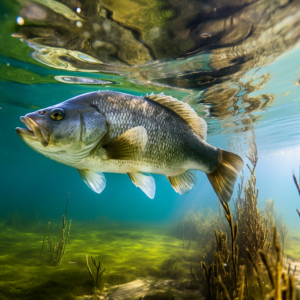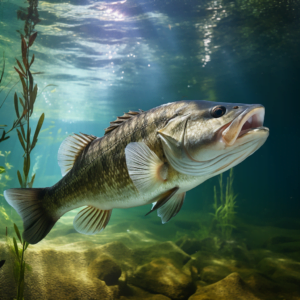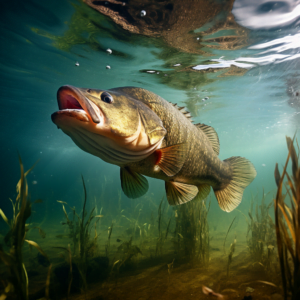Have you ever wondered if it is safe to eat a bass? With its popularity as a sport fish and its availability in many seafood markets, it’s a valid question to ask. In this article, we will explore the safety of consuming bass and delve into the factors that can affect its safety as a food source. By the end, you will have a better understanding of whether or not it is safe to include bass in your diet.
When it comes to the safety of eating bass, it is essential to consider the source of the fish. Bass can be found in both freshwater and saltwater environments, and the quality of their habitat plays a significant role in their safety as food. Fish that reside in polluted waters or are exposed to contaminants are more likely to accumulate toxins in their bodies. Therefore, it is crucial to choose bass that come from clean and well-maintained water sources.
Another factor to consider is the size and age of the bass. Older and larger bass have higher levels of mercury and other heavy metals due to bioaccumulation. These toxic substances can be harmful to the human body, particularly for pregnant women and young children. It is recommended to consume smaller and younger bass, as they are less likely to have accumulated high levels of contaminants.
In conclusion, the safety of eating bass depends on various factors such as the source of the fish, its habitat, and the size and age of the bass. By being mindful of these factors and making informed choices, you can enjoy bass as a safe and delicious addition to your diet. In the following article, we will further examine the nutritional benefits of bass and provide you with some tasty recipes to try. So stay tuned!
Bass as a Popular Fish
Bass, a freshwater fish, is widely recognized and loved by many for its mild and delicate flavor. Whether you enjoy the thrill of catching bass yourself or you simply enjoy its taste when served on a plate, bass has carved out a prominent place in the culinary world.
Bass as a Preferred Choice for Consumption
One of the reasons why bass is a preferred choice for consumption is its versatile flavor profile. The taste of bass can vary depending on the species, but generally, it has a deliciously mild and slightly sweet flavor. This makes it an ideal fish for a wide range of culinary preparations, from grilling and baking to pan-frying and sautéing.
In addition to its appealing flavor, bass is also highly valued for its firm and flaky texture. The meat of a bass fillet is tender, with a pleasing mouthfeel that adds to the overall dining experience. Its texture makes it a perfect choice for various cooking techniques and recipes.
Different Species of Bass That Are Consumed
There are several different species of bass that are consumed worldwide. Some popular types of bass include largemouth bass, smallmouth bass, striped bass, and white bass. Each of these species has its own unique characteristics that make them desirable for consumption.
Largemouth bass, for example, is known for its larger size and flaky texture. It is often prized for its meaty fillets and is commonly found in North America. On the other hand, smallmouth bass is smaller in size but has a firmer texture and slightly more pronounced flavor. Striped bass, sometimes referred to as rockfish, has a mild and sweet flavor, while white bass has a delicate and flaky texture.
Health Benefits of Eating Bass
In addition to its delectable taste and versatility, bass also offers several health benefits that make it a nutritious choice for your diet.
Excellent Source of Protein
Protein is an essential nutrient that plays a vital role in building and repairing tissues, as well as supporting the growth and maintenance of muscles. Bass is rich in high-quality protein, making it an excellent source of this essential nutrient. Consuming bass can help you meet your daily protein requirements and support overall health.
Rich in Omega-3 Fatty Acids
Omega-3 fatty acids are a type of polyunsaturated fat that is renowned for its numerous health benefits. These fatty acids cannot be produced by the body and must be obtained through diet. Bass, particularly striped bass and largemouth bass, is a good source of omega-3 fatty acids. These healthy fats have been linked to a reduced risk of heart disease, improved brain function, and decreased inflammation in the body.
Good for Heart Health
Heart disease is a significant health concern globally, and adopting a heart-healthy diet is essential for maintaining cardiovascular health. Bass consumption can play a role in promoting heart health due to its rich omega-3 fatty acid content. Omega-3s have been shown to reduce blood pressure, lower triglyceride levels, and decrease the risk of heart disease.
Promotes Brain Health
Omega-3 fatty acids are also crucial for optimal brain health and cognitive function. These fatty acids play a vital role in the development and maintenance of the brain. By including bass in your diet, you can provide your body with the necessary nutrients to support brain health, potentially reducing the risk of cognitive decline and improving memory and concentration.
Potential Risks to Consider
While the consumption of bass offers a wide range of benefits, it is important to be aware of certain risks associated with eating this fish.
Mercury Contamination
Mercury is a naturally occurring element that can be found in varying levels in many fish, including bass. It is a toxic substance that can have harmful effects on the nervous system, particularly in unborn babies and young children. Therefore, it is essential to be mindful of mercury levels when consuming bass or any other fish that may contain this heavy metal.
Environmental Pollution
Bass, like many other fish, can be exposed to environmental pollutants such as PCBs (polychlorinated biphenyls) and dioxins. These pollutants can accumulate in the fatty tissues of the fish and pose health risks when ingested. To minimize exposure to these pollutants, it is advisable to choose bass from clean and unpolluted water sources.
Harmful Effects of Overconsumption
While bass can be a healthy addition to your diet, overconsumption may lead to certain health risks. As with any food, moderation is key. Bass, like other fish, contains trace amounts of contaminants. Therefore, consuming large quantities of bass on a regular basis may increase the overall exposure to these contaminants. To minimize potential risks, it is recommended to consume bass in moderation as part of a varied and balanced diet.
Tips for Choosing and Preparing Bass
When it comes to choosing and preparing bass, there are a few tips that can help you make the most of this flavorful fish.
Buying Fresh and Sustainable Bass
When purchasing bass, it is important to choose fresh fish that is sustainably sourced. Look for clear, bright eyes and shiny skin. The flesh should be firm and spring back when touched. If possible, opt for bass that has been caught using sustainable fishing practices, ensuring the long-term viability of fish populations and minimizing the impact on the environment.
Proper Storage and Cooking Techniques
To maintain the quality and freshness of bass, it is crucial to store it properly. Keep the fish refrigerated at temperatures below 40°F (4°C) and use it within two days of purchase. If you don’t plan to cook it immediately, you can also freeze bass for later use. When cooking, it is important to handle bass with care to avoid overcooking, as this can result in a dry and less flavorful dish.
Avoiding Overcooking for Optimal Taste
Bass is a delicate fish that can easily become dry and lose its flavor if overcooked. To ensure optimal taste and texture, it is recommended to cook bass until it is just cooked through and flakes easily with a fork. Overcooking can result in a less enjoyable dining experience, so be sure to keep a close eye on the cooking time and temperature.
Delicious Bass Recipes to Try
Now that you have a better understanding of the potential health benefits, risks, and best practices when it comes to choosing and cooking bass, let’s explore a few delicious recipes that showcase the versatility of this popular fish.
Grilled Lemon Herb Bass
Ingredients:
- 4 bass fillets
- 2 tablespoons olive oil
- Juice of 1 lemon
- 2 cloves garlic, minced
- 1 tablespoon fresh herbs (such as basil, thyme, or dill)
- Salt and pepper to taste
Instructions:
- Preheat the grill to medium-high heat.
- In a small bowl, whisk together the olive oil, lemon juice, minced garlic, fresh herbs, salt, and pepper.
- Brush the marinade onto the bass fillets, ensuring they are well coated.
- Grill the bass fillets for 4-5 minutes per side until they are cooked through and flake easily with a fork.
- Serve the grilled bass with a squeeze of fresh lemon juice and garnish with additional herbs if desired.
Pan-Seared Bass with Garlic and Butter
Ingredients:
- 4 bass fillets
- 2 tablespoons butter
- 2 cloves garlic, minced
- Juice of 1 lemon
- Salt and pepper to taste
- Fresh parsley for garnish
Instructions:
- Heat the butter in a skillet over medium-high heat.
- Add the minced garlic and cook for 1-2 minutes until fragrant.
- Season the bass fillets with salt and pepper.
- Place the fillets in the skillet and cook for 3-4 minutes per side until golden brown and cooked through.
- Squeeze the lemon juice over the cooked bass fillets.
- Garnish with fresh parsley and serve immediately.
Baked Bass with Fresh Herbs
Ingredients:
- 4 bass fillets
- 2 tablespoons olive oil
- 2 tablespoons fresh herbs (such as rosemary, thyme, or parsley)
- Salt and pepper to taste
- Lemon wedges for serving
Instructions:
- Preheat the oven to 400°F (200°C).
- Drizzle the bass fillets with olive oil and season with salt, pepper, and the fresh herbs.
- Place the seasoned fillets on a baking sheet lined with parchment paper.
- Bake the bass in the preheated oven for 12-15 minutes or until cooked through and flaky.
- Serve the baked bass with lemon wedges for squeezing over the top.
Sustainable Fishing Practices
As consumers, it is important to support sustainable fishing practices to ensure the long-term viability of fish populations and the health of our oceans.
The Importance of Sustainable Fishing
Sustainable fishing practices aim to minimize the impact on the environment while ensuring the continued availability of fish for future generations. This involves using methods that avoid overfishing and reduce bycatch, such as the use of selective fishing gear and fishing quotas.
By supporting sustainable fishing practices, you can play a role in preserving the delicate balance of marine ecosystems and protecting fish populations for years to come.
Supporting Local and Responsible Fishermen
When purchasing bass or any other fish, consider buying from local and responsible fishermen who adhere to sustainable fishing practices. Local fishermen often have a direct connection to the fish they catch, ensuring the freshness and quality of their products. By supporting these fishermen, you not only contribute to the local economy but also help create a demand for sustainable fishing practices.
Regulations and Certifications
To ensure the safety and sustainability of the fish we consume, various regulations and certifications are in place.
Government Regulations on Fishing
Government regulations play a crucial role in managing and protecting fish populations. These regulations establish catch limits, size restrictions, and fishing seasons to prevent overfishing and promote sustainable fishing practices. Compliance with these regulations helps maintain fish populations at healthy levels and ensures the long-term viability of the species.
Certifications and Labels to Look for When Buying Bass
Certifications and labels can provide valuable information about the sustainability and quality of the bass you are purchasing. Look for labels such as the Marine Stewardship Council (MSC), which certifies that the fish comes from a sustainable fishery. Additionally, certifications like the Best Aquaculture Practices (BAP) and the Global Aquaculture Alliance (GAA) ensure responsible aquaculture practices.
Alternative Fish Options
While bass offers many benefits and is a popular choice for consumption, there are several other fish you can consider adding to your diet.
Other Popular Fish for Consumption
Salmon, trout, tilapia, and cod are some of the other popular fish species that are enjoyed worldwide. These fish are known for their unique flavors and nutritional benefits. Salmon, like bass, is rich in omega-3 fatty acids, while trout offers a delicate and buttery flavor. Tilapia is a mild and versatile fish, and cod has a firm and flaky texture.
Comparing Nutritional Values and Taste
When choosing fish to include in your diet, it can be helpful to compare their nutritional values and taste profiles. Consider factors such as protein content, omega-3 fatty acid levels, and overall flavor to find fish that align with your dietary preferences and health goals.
Bass in Different Cuisines
Bass has found its way into the culinary traditions of various cuisines around the world, adding its unique flavor to a wide range of dishes.
Bass in Mediterranean Cuisine
In Mediterranean cuisine, bass is often prepared simply to allow its natural flavors to shine. Grilled bass with lemon and herbs is a classic dish that highlights the delicate taste of the fish. Bass is also commonly used in stews and soups, adding depth and richness to these dishes.
Bass in Asian Cuisine
Bass is a popular ingredient in Asian cuisine, particularly in countries like China and Thailand. It is often used in steamed dishes, stir-fries, and fish curries. The mild and tender flesh of bass pairs well with the bold and aromatic flavors commonly found in Asian dishes.
Bass in American Cuisine
In American cuisine, bass is a prized fish that is enjoyed in various preparations. It is commonly fried or pan-seared and served with a side of vegetables or rice. Bass is also often used in fish tacos or as the main ingredient in fish chowders.
Conclusion
In conclusion, bass can be a safe and nutritious choice for consumption when consumed in moderation and from clean and unpolluted water sources. It offers a range of health benefits, including being an excellent source of protein and omega-3 fatty acids. However, it is important to be mindful of potential risks such as mercury contamination and the harmful effects of overconsumption.
By following proper storage and cooking techniques, choosing sustainably sourced bass, and considering alternative fish options, you can enjoy the delicious taste of bass while making informed choices for your health and the environment. So go ahead, indulge in a delicious bass dish and savor the flavors of this popular fish.




